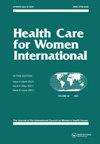对肯尼亚西部计划生育障碍的混合方法旅程图研究结果。
IF 1.2
4区 医学
Q4 PUBLIC, ENVIRONMENTAL & OCCUPATIONAL HEALTH
Health Care for Women International
Pub Date : 2024-01-01
Epub Date: 2022-11-17
DOI:10.1080/07399332.2022.2135097
引用次数: 0
摘要
我们的目标是绘制肯尼亚西部高质量计划生育护理的障碍图,并对其进行优先排序。我们在提供计划生育服务的公共机构进行了关键信息提供者访谈(n = 19);与客户进行了焦点小组讨论(n = 55);对客户进行了神秘访问(n = 180);进行了暗访(n = 120);并直接观察了客户与服务提供者之间的互动(n = 256)。我们将这些数据归纳为客户和服务提供者的旅程图,用于促进客户(n = 9)和服务提供者(n = 12)的讨论。对于这两个群体来说,缺货是经常发生的、有影响的重要障碍。客户还表示,男性伴侣的抵制、咨询不足和非正式收费也是主要障碍。本文章由计算机程序翻译,如有差异,请以英文原文为准。
Findings from a mixed-methods journey map study of barriers to family planning in western Kenya.
Our objective was to map and prioritize barriers to high-quality family planning care in western Kenya. We conducted key informant interviews (n = 19); focus group discussions with clients (n = 55); mystery client visits (n = 180); unannounced visitors (n = 120); and direct observation of client-provider interactions (n = 256) at public facilities offering family planning. We synthesized the data into a client and a provider journey map, which we used to facilitate client (n = 9) and provider (n = 12) discussions. For both groups, stockouts were frequent, impactful, and important barriers. Clients also reported male partner resistance, insufficient counseling, and informal fees were priority barriers.
求助全文
通过发布文献求助,成功后即可免费获取论文全文。
去求助
来源期刊

Health Care for Women International
Multiple-
CiteScore
3.30
自引率
7.10%
发文量
91
期刊介绍:
Health Care for Women International is a critically acclaimed, international publication that provides a unique interdisciplinary approach to health care and related topics that concern women around the globe. Published twelve times a year, Health Care for Women International includes the newest research, theories, and issues in the fields of public health, social science, health care practice, and health care policy. Scholars and practitioners address topics such as cultural differences, alternative lifestyles, domestic violence, public health issues associated with the aging of the population, maternal morbidity and mortality, infectious diseases, and a host of other gender-based ethical issues. The editor also encourages discussion topics, inviting readers to comment on articles that focus on specific aspects of health issue for women.
 求助内容:
求助内容: 应助结果提醒方式:
应助结果提醒方式:


